Home / Naming Bicyclic Compounds – Fused, Bridged, and Spiro
Conformations and Cycloalkanes
Naming Bicyclic Compounds – Fused, Bridged, and Spiro
Last updated: September 30th, 2025 |
Bicyclic Compounds – Fused Rings, Bridged Bicyclic Rings, and Spiro Bicyclic Rings
In the previous post we started our discussion of structures with more than one ring, using decalin as our key example of a fused ring. We saw how much the stereochemistry at the ring junction can affect the overall shape of the molecule, as well as its stability.
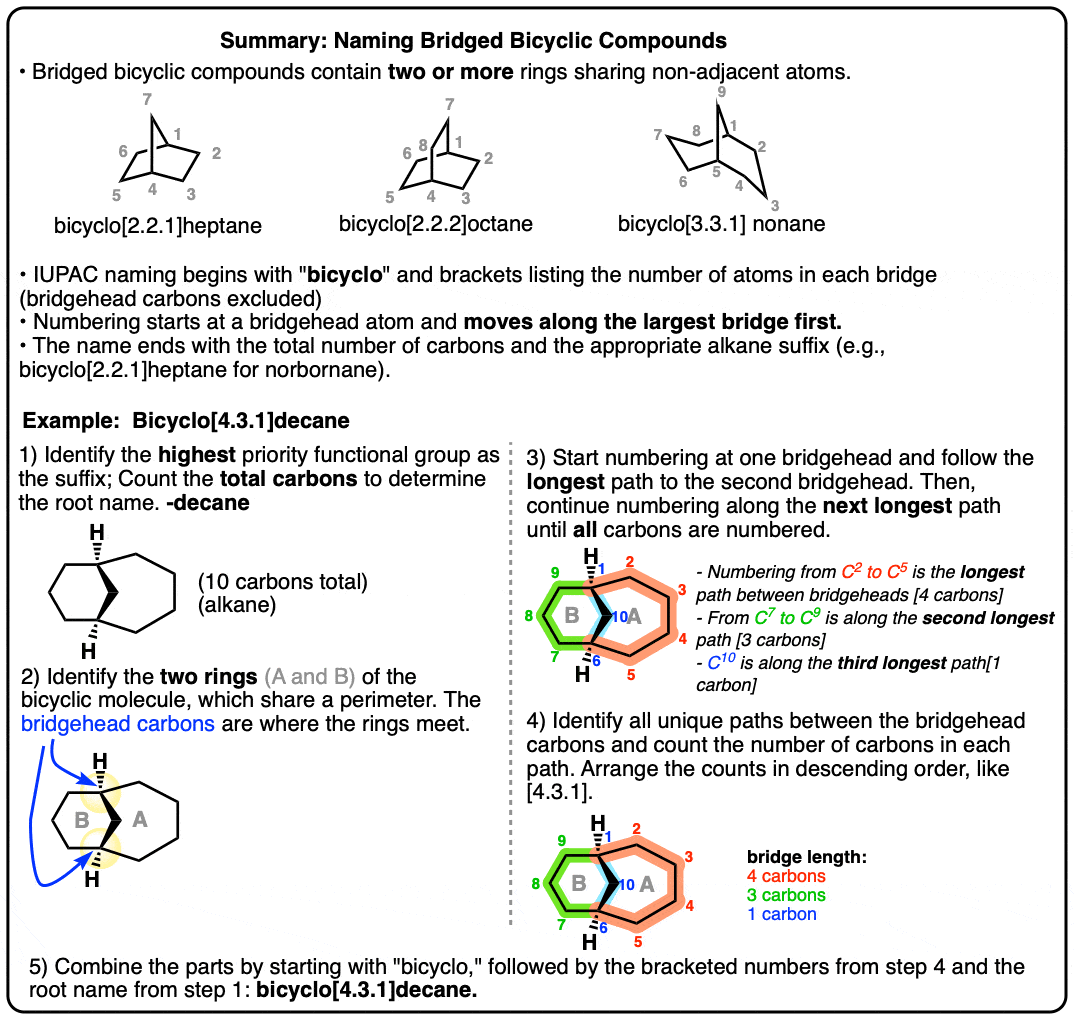
Table of Contents
- Ring Junctions: Fused Rings, Bridged Bicyclic Rings, and Spiro Rings
- In Or Out? Either Both In, Or Both Out!
- Putting Bridged Bicyclic Compounds In Perspective
- Naming Bridged Bicyclic Compounds – A Five-Step Guide
- A Few More Examples Of Bridged Bicyclic Molecules
- Naming Spiro Compounds
- Summary: Naming Bicyclic Compounds
- Notes (and a complex example)
- (Advanced) References and Further Reading
1. Fused Rings, Bridged Bicyclic Rings, And Spiro Rings
What we didn’t talk about is that the ring junction of decalin represents only one way to arrange the ten carbons of decalin into a pair of adjacent rings: the so-called “fused” ring structure, where the two “bridgehead” carbons are directly connected.
There are actually two other modes of ring junction. In “bridged bicyclic” molecules, the two bridgeheads are separated by “bridges” containing at least one carbon. In “spiro” fused molecules, the two rings are both joined at the same carbon.
In this post we’ll focus on “bridged bicyclic” molecules (and how to name them), and also briefly touch on “spiro” fused bicyclic molecules.
By the way, in the diagram below, only one “bridged bicyclic” isomer of decalin with a six-membered ring is drawn. Can you find the other bridged bicyclic isomer that also contains a six-membered ring? (Answer in Note 1)
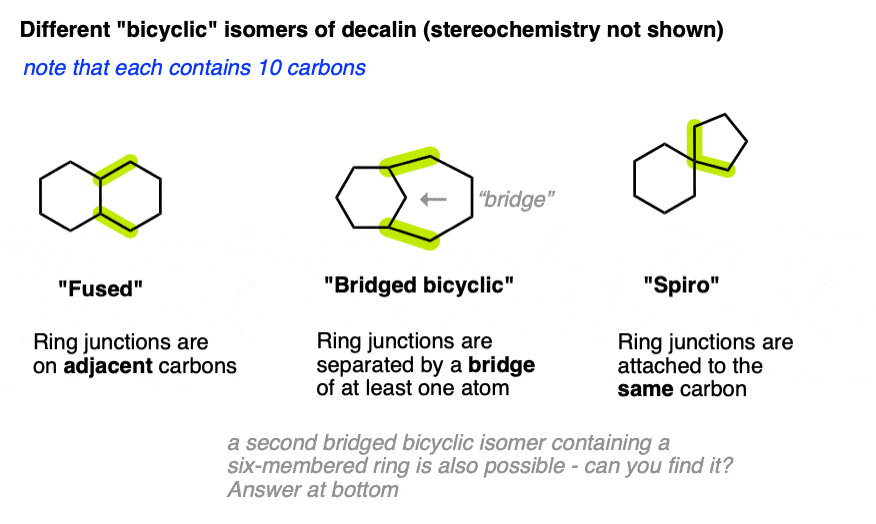
2. In Or Out? Either Both In, Or Both Out.
First, stereochemistry. One important note about bridged bicyclic molecules is that the two carbons forming each bridge will always be “cis” to each other, never trans, relative to the other ring.* [exceptions? yes, but you probably won’t see ’em – check Note 2 if you’re curious]
Why? Like we said in the last post when discussing trans-decalin, for much the same reason that you can’t kiss yourself on the back – there just isn’t enough flexibility for this to happen without breaking something. Given the strict bond angle (109°) and length (1.50 Å) requirements of alkanes, five, six, and seven membered rings don’t have enough slack to tolerate anything other than cis ring junctions. A trans ring junction (much like a trans double bond in rings of these sizes) would simply lead to too much ring strain.
Note that in the diagram below, the “cis” ring junctions is implied by the fact that both hydrogens are on the same side (both dashes in this case). The “impossible” trans ring junction is shown in grayscale for comparison. The picture shows a model of this molecule highlighting the angle strain and Van Der Waals strain resulting from this arrangement.
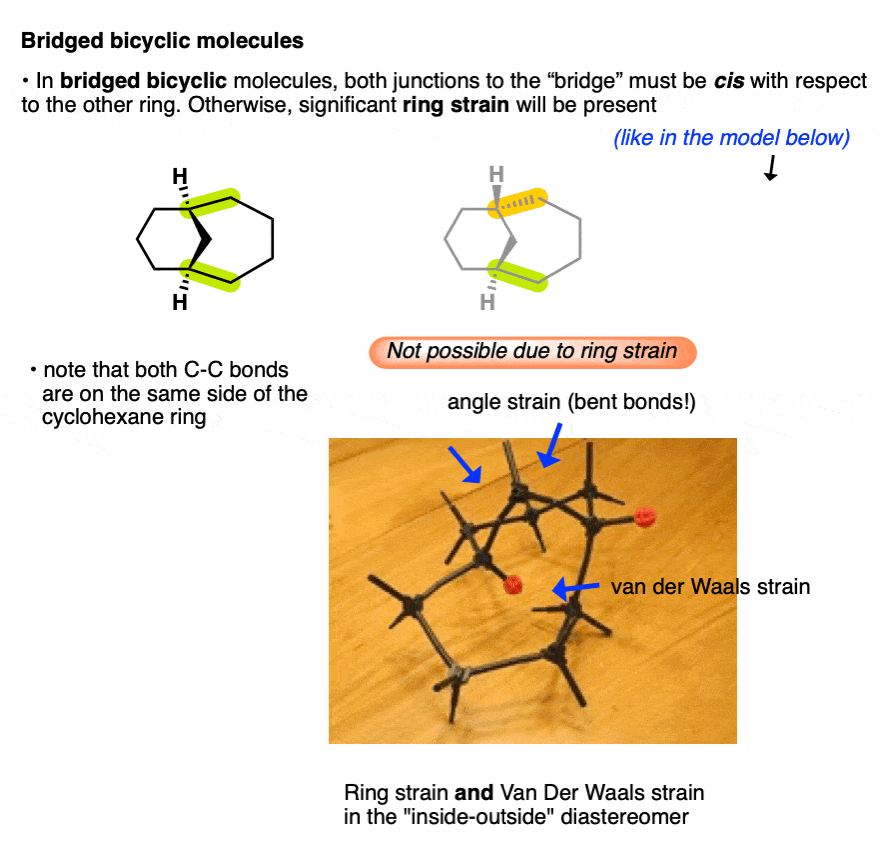
3. Putting Bridged Compounds In Perspective
Next – and this is where a lot of students get confused – we come to the topic of how to depict these things. Merely using dashes and wedges doesn’t truly capture their three-dimensional beauty.
So when drawing bridged bicyclic molecules, it’s very common to show them in perspective from the side. The first reaction my students have upon seeing these drawings is utter disgust and confusion. “What is THAT?”, I recall Mike from Sault Ste. Marie asking me one night during a tutoring session.
It’s the same thing as the “top down” view, just drawn from a different perspective. Using the “top down” view is a perfectly acceptable way to draw these molecules – however, it’s vital to be able to interpret these “perspective” drawings as many bicyclic molecules in your textbook will be shown in this way.
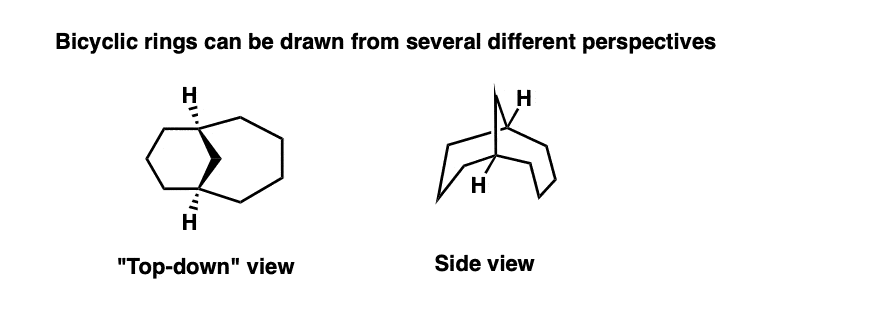
Here’s a “flyover” view of the same molecule, from top-down to the side-view. [BTW: note how the six membered ring on the left is in the chair conformation]
4. Naming Bridged Bicyclic Molecules – A Five-Step Guide
The naming of bridged bicycles has its own special kind of funk. Unlike the molecules you’ve likely come across so far, which will have a clear “longest chain” or “largest ring” to start from, trying to find the place to start based on those criteria alone will likely have you going in circles.
Instead, bridged bicycles are named according to a unique system of their own. based on the length of their bridges, and then the overall number of carbons in the bicycle. The figure below walks through the process.
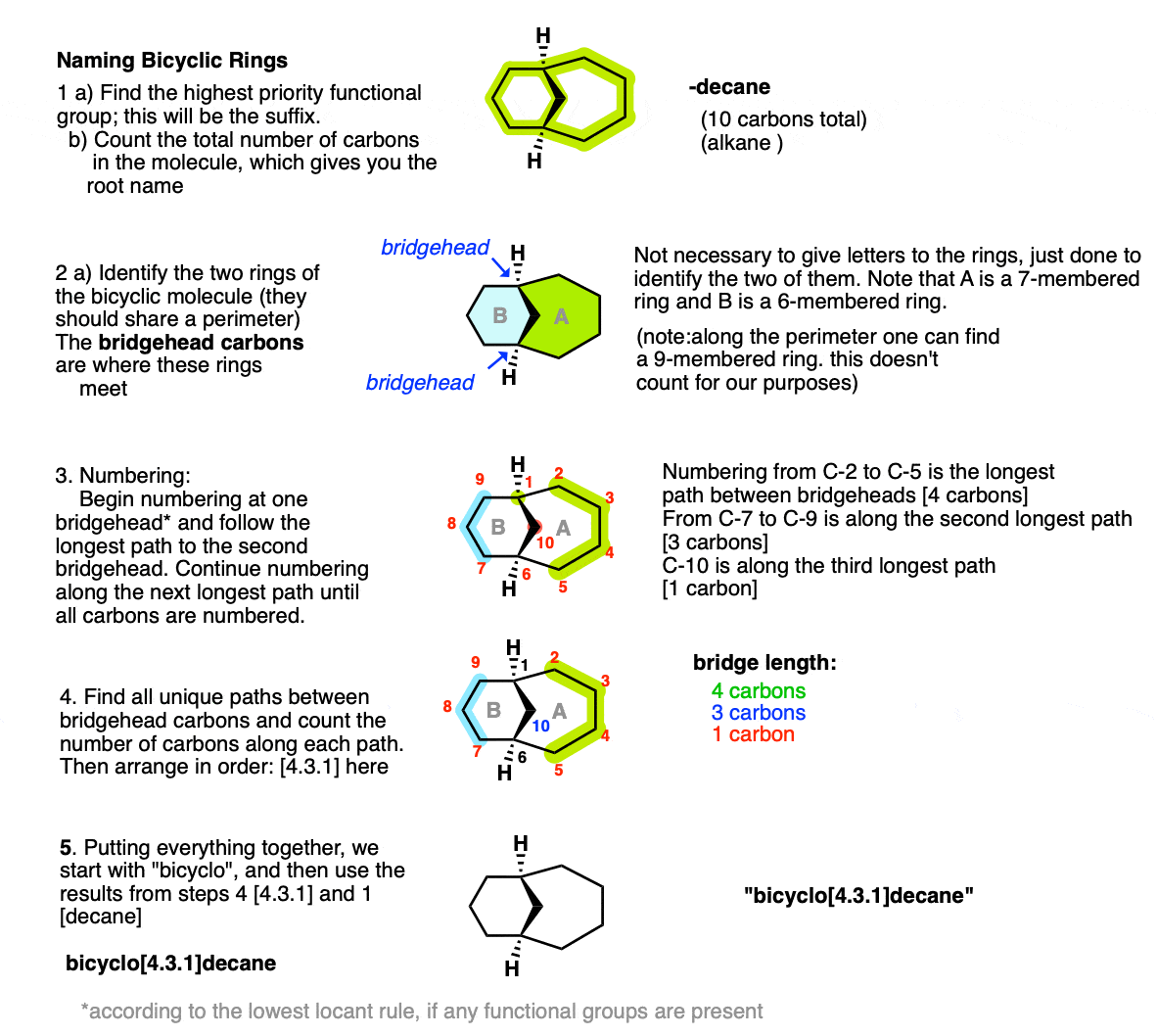
5. A Few More Examples Of Bicyclic Molecules
Once you’ve run through a few examples by yourself, I think you’ll find that naming bridged bicyclic molecules is actually fairly intuitive – as long as you can interpret the diagrams correctly. [Try making a model if you’re still stuck!] See if you can follow the naming of these compounds.
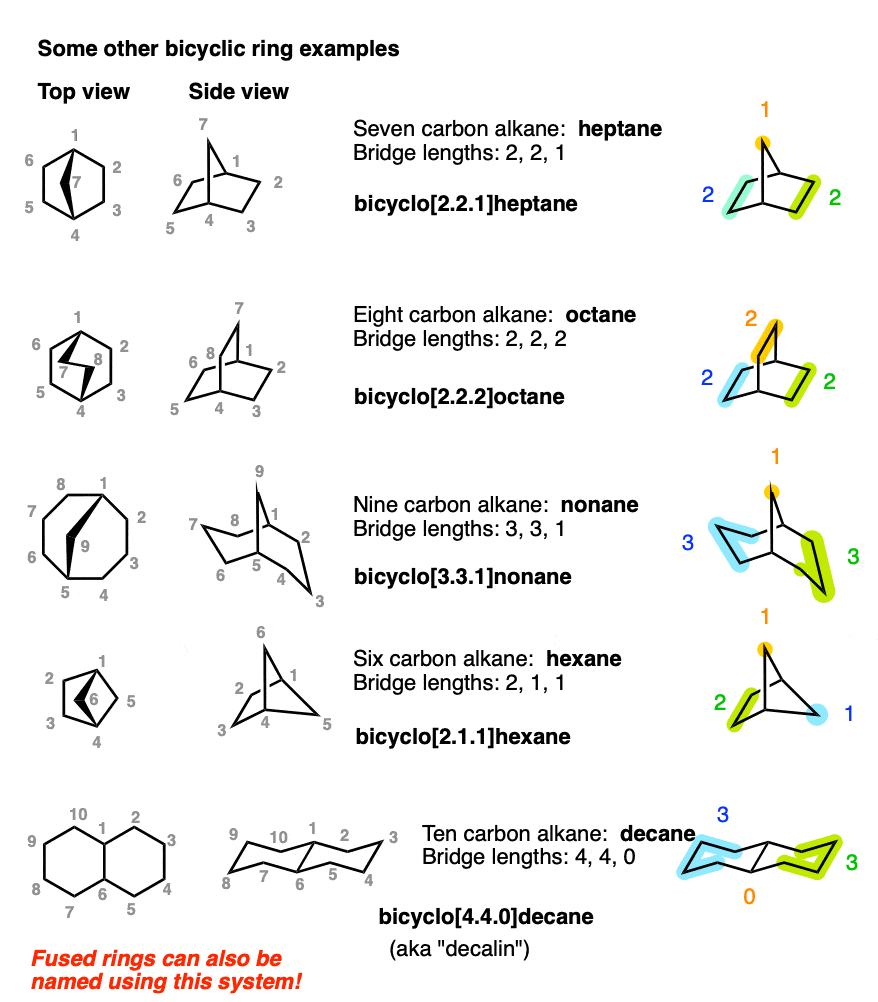
See that last example? We can also use bridged bicycle nomenclature to name fused rings as well! So bicyclo[4.4.0]decane is simply another name for “decalin” (without specifying the stereochemistry, of course).
6. Naming Spiro Compounds
Let’s wrap up by briefly covering “spiro” fused compounds. Since both “bridgehead” positions are on the same carbon, we won’t be able to use the same “bicyclo” nomenclature as before- but the process is very similar.
We simply substitute “spiro” for “bicyclo” , insert the two bridge lengths, and place the suffix as before. So the molecule below is spiro[5.4]decane. Included next door are two other examples of spiro compounds, spiro[4.3]octane and spiro[5.2]octane.
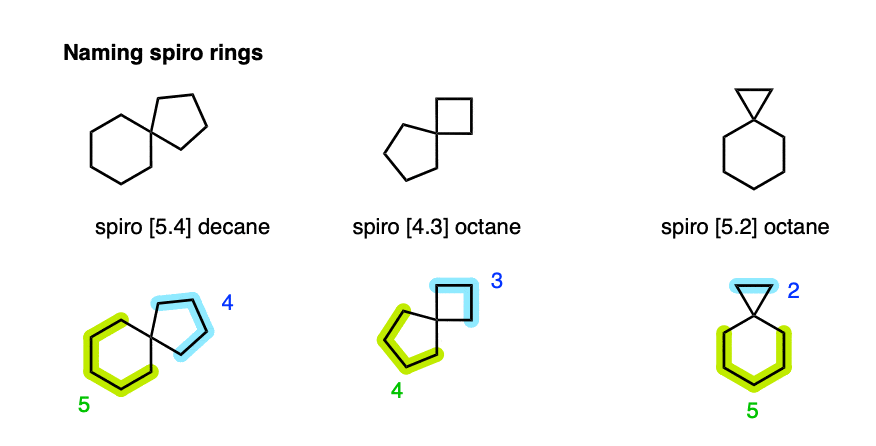
7. Summary: Naming Bicyclic Compounds
In the next post – and last in this series – we’ll talk about one final, very interesting consequence of the fact that carbons can form rings: Bredt’s Rule.
Next post: Bredt’s Rule
Notes:
Related Articles
- Bredt’s Rule (And Summary of Cycloalkanes)
- Fused Rings – Cis-Decalin and Trans-Decalin
- Cyclohexane Chair Conformation Stability: Which One Is Lower Energy?
- The Cyclohexane Chair Flip – Energy Diagram
- Cycloalkanes – Ring Strain In Cyclopropane And Cyclobutane
- Calculation of Ring Strain In Cycloalkanes
- Cycloalkanes Practice Problems (MOC Membership)
Note 1. Did you find the other bridged bicyclic isomer of decane that contains a six-membered ring? Here it is: bicyclo[4.2.2]decane.
Note that the key difference is the presence of two 2-carbon bridges (in addition to the 4 carbon bridge) in contrast to the 1 and 3-carbon bridges seen in bicyclo[4.3.1]decane.

Note 2. Secondly, a note about bridged ring fusions. Like with Bredt’s rule (more on that next post) once the size of the ring perimeter gets large enough [11 seems to be the minimum], the rules can be bent a bit. There are known examples of molecules with trans bridgehead ring fusions, sometimes known as “inside-outside” isomerism. A very prominent example is the natural product ingenol, isolated from Euphorbia species. A close look at the [4.4.1]undecane ring structure reveals that the two carbons on one of the bridges are in fact trans to each other. This does lead to ring strain [about 5.9 kcal/mol according to one calculation], but not enough to render closure of the ring impossible.
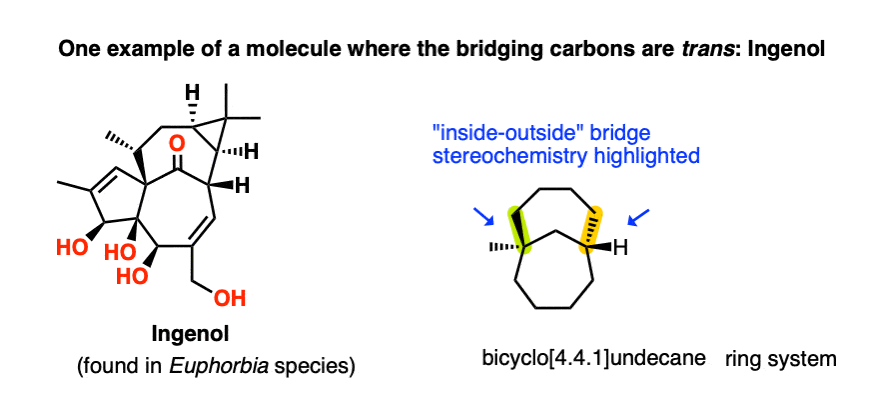
By the way, ingenol is a fascinating target for testing the limits of modern organic synthesis. Isolated in 1968, it was not synthesized until 2002 by Jeffrey Winkler’s group at Penn. Subsequently the molecule has been synthesized by the groups of Wood and most recently (and impressively) by Baran. If you’re an undergraduate interested in studying organic synthesis, Mark Peczuh has written a tour de force walkthrough of Winkler’s ingenol synthesis that explains the thinking behind the synthesis line-by-line. The Baran group also has a post on their blog, Open Flask, that gives the behind-the-scenes story of their ingenol synthesis and really conveys the flavour of what working on a total synthesis project is like.
Note 3. Building Up A Complex Bridged Bicyclic Molecule From Its Name.
Commenter Hamid requested how to draw the structure for 6-endo-bromo-8-anti-isobutyl-1,3-exo-dimethylbicyclo[3.2.1]octane.
So here’s how you do it.
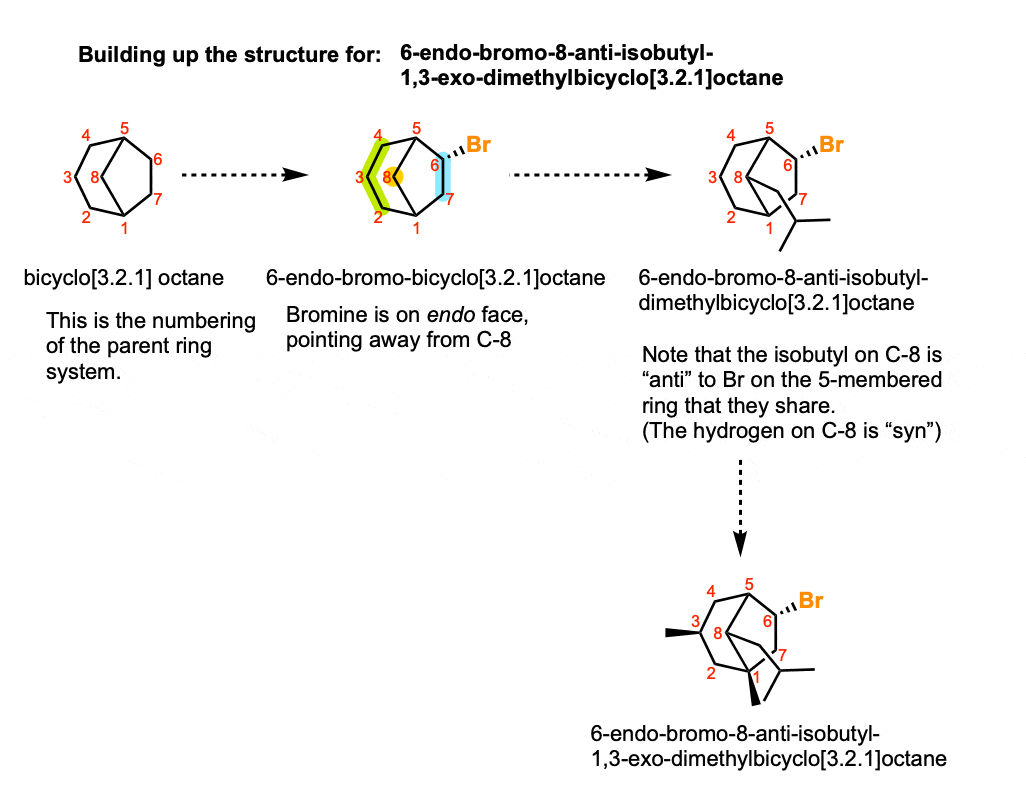
(Advanced) References and Further Reading
References to chemical curiosities related to bridged bicyclic rings; propellanes, strained bridged molecules, inside-outside bicyclic rings, and the total synthesis of natural products containing these features.
- Bicyclo[1.1.1]pentane
Kenneth B. Wiberg and Daniel S. Connor
Journal of the American Chemical Society 1966, 88 (19), 4437-4441
DOI: 1021/ja00971a025
Prof. Wiberg was a pioneer in the synthesis and study of bicyclic hydrocarbons and synthesized many of the ‘propellanes’ in the course of his career. This paper is on the synthesis and study of the smallest bridged bicyclic ring, bicyclo[1.1.1]pentane, which later led to the synthesis of [1.1.1]Propellane. Interestingly, closing the bridge was performed using the Wurtz reaction (the sodium “cousin” of the Grignard reaction), one of its few successful applications. - A survey of strained organic molecules
Joel F. Liebman and Arthur Greenberg
Chemical Reviews 1976, 76 (3), 311-365
DOI: 1021/cr60301a002
An old but still nonetheless useful review on strained organic molecules. - The structures of norbornane and 1,4-dichloronorbornane as determined by electron diffraction
J. F. Chiang, C. F. Wilcox, and S. H. Bauer
Journal of the American Chemical Society 1968, 90 (12), 3149-3157
DOI: 10.1021/ja01014a032
According to this paper, bicyclo[2.2.1]heptane (more commonly known as “norbornane”) has a ring strain of 17.5 kcal/mol. The natural product camphor, responsible for the familiar smell of Vicks’ Vapo-Rub, has the same bridged ring system. - Chemistry of bent bonds. XXX. Diels-Alder approach to inside-outside bicyclics
Paul G. Gassman and Randolph P. Thummel
Journal of the American Chemical Society 1972, 94 (20), 7183-7184
DOI: 10.1021/ja00775a070
Paul Gassman (U Minnesota) was a very eminent organic chemist of the 20th century. In this paper he describes the synthesis of inside-outside bicyclic compounds using the Diels-Alder reaction. - Bicyclo[8.8.8]hexacosane. Out, in isomerism
C. H. Park and H. E. Simmons
Journal of the American Chemical Society 1972, 94 (20), 7184-7186
DOI: 10.1021/ja00775a071
The following paper after Prof. Gassman’s (Ref. #4 above) is on the same topic. Interestingly, this is submitted by H. E. Simmons (DuPont), of the Simmons-Smith reaction. - Inside-outside stereoisomerism: the synthesis of trans-bicyclo[5.3.1]undecane-11-one
Jeffrey D. Winkler, John P. Hey, and Paul G. Williard
Journal of the American Chemical Society 1986, 108 (20), 6425-6427
DOI: 10.1021/ja00280a071
This paper details a synthetic path to a small bicyclic molecule (potentially the smallest) to demonstrate in-out isomerism. This is useful for the synthesis of ingenane diterpenes, as the authors note. - Development of a Concise Synthesis of (+)-Ingenol
Steven J. McKerrall, Lars Jørgensen, Christian A. Kuttruff, Felix Ungeheuer, and Phil S. Baran
Journal of the American Chemical Society 2014, 136 (15), 5799-5810
DOI: 10.1021/ja501881p
Ingenol is a nature product featuring a bicyclic system with in/out stereochemistry, and this paper by the laboratory of Prof. Phil Baran is on its stereospecific synthesis.
00 General Chemistry Review
01 Bonding, Structure, and Resonance
- How Do We Know Methane (CH4) Is Tetrahedral?
- Hybrid Orbitals and Hybridization
- How To Determine Hybridization: A Shortcut
- Orbital Hybridization And Bond Strengths
- Sigma bonds come in six varieties: Pi bonds come in one
- Dipole Moments and Dipoles
- A Key Skill: How to Calculate Formal Charge
- The Four Intermolecular Forces and How They Affect Boiling Points
- 3 Trends That Affect Boiling Points
- How To Use Electronegativity To Determine Electron Density (and why NOT to trust formal charge)
- Introduction to Resonance
- How To Use Curved Arrows To Interchange Resonance Forms
- Evaluating Resonance Forms (1) - The Rule of Least Charges
- How To Find The Best Resonance Structure By Applying Electronegativity
- Evaluating Resonance Structures With Negative Charges
- Evaluating Resonance Structures With Positive Charge
- Exploring Resonance: Pi-Donation
- Exploring Resonance: Pi-acceptors
- In Summary: Evaluating Resonance Structures
- Drawing Resonance Structures: 3 Common Mistakes To Avoid
- How to apply electronegativity and resonance to understand reactivity
- Bond Hybridization Practice
- Structure and Bonding Practice Quizzes
- Resonance Structures Practice
02 Acid Base Reactions
- Introduction to Acid-Base Reactions
- Acid Base Reactions In Organic Chemistry
- The Stronger The Acid, The Weaker The Conjugate Base
- Walkthrough of Acid-Base Reactions (3) - Acidity Trends
- Five Key Factors That Influence Acidity
- Acid-Base Reactions: Introducing Ka and pKa
- How to Use a pKa Table
- The pKa Table Is Your Friend
- A Handy Rule of Thumb for Acid-Base Reactions
- Acid Base Reactions Are Fast
- pKa Values Span 60 Orders Of Magnitude
- How Protonation and Deprotonation Affect Reactivity
- Acid Base Practice Problems
03 Alkanes and Nomenclature
- Meet the (Most Important) Functional Groups
- Condensed Formulas: Deciphering What the Brackets Mean
- Hidden Hydrogens, Hidden Lone Pairs, Hidden Counterions
- Don't Be Futyl, Learn The Butyls
- Primary, Secondary, Tertiary, Quaternary In Organic Chemistry
- Branching, and Its Affect On Melting and Boiling Points
- The Many, Many Ways of Drawing Butane
- Wedge And Dash Convention For Tetrahedral Carbon
- Common Mistakes in Organic Chemistry: Pentavalent Carbon
- Table of Functional Group Priorities for Nomenclature
- Summary Sheet - Alkane Nomenclature
- Organic Chemistry IUPAC Nomenclature Demystified With A Simple Puzzle Piece Approach
- Boiling Point Quizzes
- Organic Chemistry Nomenclature Quizzes
04 Conformations and Cycloalkanes
- Staggered vs Eclipsed Conformations of Ethane
- Conformational Isomers of Propane
- Newman Projection of Butane (and Gauche Conformation)
- Introduction to Cycloalkanes
- Geometric Isomers In Small Rings: Cis And Trans Cycloalkanes
- Calculation of Ring Strain In Cycloalkanes
- Cycloalkanes - Ring Strain In Cyclopropane And Cyclobutane
- Cyclohexane Conformations
- Cyclohexane Chair Conformation: An Aerial Tour
- How To Draw The Cyclohexane Chair Conformation
- The Cyclohexane Chair Flip
- The Cyclohexane Chair Flip - Energy Diagram
- Substituted Cyclohexanes - Axial vs Equatorial
- Ranking The Bulkiness Of Substituents On Cyclohexanes: "A-Values"
- Cyclohexane Chair Conformation Stability: Which One Is Lower Energy?
- Fused Rings - Cis-Decalin and Trans-Decalin
- Naming Bicyclic Compounds - Fused, Bridged, and Spiro
- Bredt's Rule (And Summary of Cycloalkanes)
- Newman Projection Practice
- Cycloalkanes Practice Problems
05 A Primer On Organic Reactions
- The Most Important Question To Ask When Learning a New Reaction
- Curved Arrows (for reactions)
- Nucleophiles and Electrophiles
- The Three Classes of Nucleophiles
- Nucleophilicity vs. Basicity
- What Makes A Good Nucleophile?
- What Makes A Good Leaving Group?
- 3 Factors That Stabilize Carbocations
- Equilibrium and Energy Relationships
- 7 Factors that stabilize negative charge in organic chemistry
- 7 Factors That Stabilize Positive Charge in Organic Chemistry
- What's a Transition State?
- Hammond's Postulate
- Learning Organic Chemistry Reactions: A Checklist (PDF)
06 Free Radical Reactions
- Free Radical Reactions
- 3 Factors That Stabilize Free Radicals
- Bond Strengths And Radical Stability
- Free Radical Initiation: Why Is "Light" Or "Heat" Required?
- Initiation, Propagation, Termination
- Monochlorination Products Of Propane, Pentane, And Other Alkanes
- Selectivity In Free Radical Reactions
- Selectivity in Free Radical Reactions: Bromination vs. Chlorination
- Halogenation At Tiffany's
- Allylic Bromination
- Bonus Topic: Allylic Rearrangements
- In Summary: Free Radicals
- Synthesis (2) - Reactions of Alkanes
- Free Radicals Practice Quizzes
07 Stereochemistry and Chirality
- Types of Isomers: Constitutional Isomers, Stereoisomers, Enantiomers, and Diastereomers
- How To Draw The Enantiomer Of A Chiral Molecule
- How To Draw A Bond Rotation
- Introduction to Assigning (R) and (S): The Cahn-Ingold-Prelog Rules
- Assigning Cahn-Ingold-Prelog (CIP) Priorities (2) - The Method of Dots
- Enantiomers vs Diastereomers vs The Same? Two Methods For Solving Problems
- Assigning R/S To Newman Projections (And Converting Newman To Line Diagrams)
- How To Determine R and S Configurations On A Fischer Projection
- The Meso Trap
- Optical Rotation, Optical Activity, and Specific Rotation
- Optical Purity and Enantiomeric Excess
- What's a Racemic Mixture?
- Chiral Allenes And Chiral Axes
- Stereochemistry Practice Problems and Quizzes
08 Substitution Reactions
- Nucleophilic Substitution Reactions - Introduction
- Two Types of Nucleophilic Substitution Reactions
- The SN2 Mechanism
- Why the SN2 Reaction Is Powerful
- The SN1 Mechanism
- The Conjugate Acid Is A Better Leaving Group
- Comparing the SN1 and SN2 Reactions
- Polar Protic? Polar Aprotic? Nonpolar? All About Solvents
- Steric Hindrance is Like a Fat Goalie
- Common Blind Spot: Intramolecular Reactions
- Substitution Practice - SN1
- Substitution Practice - SN2
09 Elimination Reactions
- Elimination Reactions (1): Introduction And The Key Pattern
- Elimination Reactions (2): The Zaitsev Rule
- Elimination Reactions Are Favored By Heat
- Two Elimination Reaction Patterns
- The E1 Reaction
- The E2 Mechanism
- E1 vs E2: Comparing the E1 and E2 Reactions
- Antiperiplanar Relationships: The E2 Reaction and Cyclohexane Rings
- Bulky Bases in Elimination Reactions
- Comparing the E1 vs SN1 Reactions
- Elimination (E1) Reactions With Rearrangements
- E1cB - Elimination (Unimolecular) Conjugate Base
- Elimination (E1) Practice Problems And Solutions
- Elimination (E2) Practice Problems and Solutions
10 Rearrangements
11 SN1/SN2/E1/E2 Decision
- Identifying Where Substitution and Elimination Reactions Happen
- Deciding SN1/SN2/E1/E2 (1) - The Substrate
- Deciding SN1/SN2/E1/E2 (2) - The Nucleophile/Base
- SN1 vs E1 and SN2 vs E2 : The Temperature
- Deciding SN1/SN2/E1/E2 - The Solvent
- Wrapup: The Key Factors For Determining SN1/SN2/E1/E2
- Alkyl Halide Reaction Map And Summary
- SN1 SN2 E1 E2 Practice Problems
12 Alkene Reactions
- E and Z Notation For Alkenes (+ Cis/Trans)
- Alkene Stability
- Alkene Addition Reactions: "Regioselectivity" and "Stereoselectivity" (Syn/Anti)
- Stereoselective and Stereospecific Reactions
- Hydrohalogenation of Alkenes and Markovnikov's Rule
- Hydration of Alkenes With Aqueous Acid
- Rearrangements in Alkene Addition Reactions
- Halogenation of Alkenes and Halohydrin Formation
- Oxymercuration Demercuration of Alkenes
- Hydroboration Oxidation of Alkenes
- m-CPBA (meta-chloroperoxybenzoic acid)
- OsO4 (Osmium Tetroxide) for Dihydroxylation of Alkenes
- Palladium on Carbon (Pd/C) for Catalytic Hydrogenation of Alkenes
- Cyclopropanation of Alkenes
- A Fourth Alkene Addition Pattern - Free Radical Addition
- Alkene Reactions: Ozonolysis
- Oxidative Cleavage of Vicinal Diols With NaIO4 and Pb(OAc)4
- Summary: Three Key Families Of Alkene Reaction Mechanisms
- Synthesis (4) - Alkene Reaction Map, Including Alkyl Halide Reactions
- Alkene Reactions Practice Problems
13 Alkyne Reactions
- Acetylides from Alkynes, And Substitution Reactions of Acetylides
- Partial Reduction of Alkynes With Lindlar's Catalyst
- Partial Reduction of Alkynes With Na/NH3 To Obtain Trans Alkenes
- Alkyne Hydroboration With "R2BH"
- Hydration and Oxymercuration of Alkynes
- Hydrohalogenation of Alkynes
- Alkyne Halogenation: Bromination and Chlorination of Alkynes
- Oxidation of Alkynes With O3 and KMnO4
- Alkenes To Alkynes Via Halogenation And Elimination Reactions
- Alkynes Are A Blank Canvas
- Synthesis (5) - Reactions of Alkynes
- Alkyne Reactions Practice Problems With Answers
14 Alcohols, Epoxides and Ethers
- Alcohols - Nomenclature and Properties
- Alcohols Can Act As Acids Or Bases (And Why It Matters)
- Alcohols - Acidity and Basicity
- The Williamson Ether Synthesis
- Ethers From Alkenes, Tertiary Alkyl Halides and Alkoxymercuration
- Alcohols To Ethers via Acid Catalysis
- Cleavage Of Ethers With Acid
- Epoxides - The Outlier Of The Ether Family
- Opening of Epoxides With Acid
- Epoxide Ring Opening With Base
- Making Alkyl Halides From Alcohols
- Tosylates And Mesylates
- PBr3 and SOCl2
- Elimination Reactions of Alcohols
- Elimination of Alcohols To Alkenes With POCl3
- Alcohol Oxidation: "Strong" and "Weak" Oxidants
- Demystifying The Mechanisms of Alcohol Oxidations
- Protecting Groups For Alcohols
- Thiols And Thioethers
- Calculating the oxidation state of a carbon
- Oxidation and Reduction in Organic Chemistry
- Oxidation Ladders
- SOCl2 Mechanism For Alcohols To Alkyl Halides: SN2 versus SNi
- Alcohol Reactions Roadmap (PDF)
- Alcohol Reaction Practice Problems
- Epoxide Reaction Quizzes
- Oxidation and Reduction Practice Quizzes
15 Organometallics
- What's An Organometallic?
- Formation of Grignard and Organolithium Reagents
- Organometallics Are Strong Bases
- Reactions of Grignard Reagents
- Protecting Groups In Grignard Reactions
- Synthesis Problems Involving Grignard Reagents
- Grignard Reactions And Synthesis (2)
- Organocuprates (Gilman Reagents): How They're Made
- Gilman Reagents (Organocuprates): What They're Used For
- The Heck, Suzuki, and Olefin Metathesis Reactions (And Why They Don't Belong In Most Introductory Organic Chemistry Courses)
- Reaction Map: Reactions of Organometallics
- Grignard Practice Problems
16 Spectroscopy
- Degrees of Unsaturation (or IHD, Index of Hydrogen Deficiency)
- Conjugation And Color (+ How Bleach Works)
- Introduction To UV-Vis Spectroscopy
- UV-Vis Spectroscopy: Absorbance of Carbonyls
- UV-Vis Spectroscopy: Practice Questions
- Bond Vibrations, Infrared Spectroscopy, and the "Ball and Spring" Model
- Infrared (IR) Spectroscopy: A Quick Primer On Interpreting Spectra
- IR Spectroscopy: 4 Practice Problems
- 1H NMR: How Many Signals?
- Homotopic, Enantiotopic, Diastereotopic
- Diastereotopic Protons in 1H NMR Spectroscopy: Examples
- 13-C NMR - How Many Signals
- Liquid Gold: Pheromones In Doe Urine
- Natural Product Isolation (1) - Extraction
- Natural Product Isolation (2) - Purification Techniques, An Overview
- Structure Determination Case Study: Deer Tarsal Gland Pheromone
17 Dienes and MO Theory
- What To Expect In Organic Chemistry 2
- Are these molecules conjugated?
- Conjugation And Resonance In Organic Chemistry
- Bonding And Antibonding Pi Orbitals
- Molecular Orbitals of The Allyl Cation, Allyl Radical, and Allyl Anion
- Pi Molecular Orbitals of Butadiene
- Reactions of Dienes: 1,2 and 1,4 Addition
- Thermodynamic and Kinetic Products
- More On 1,2 and 1,4 Additions To Dienes
- s-cis and s-trans
- The Diels-Alder Reaction
- Cyclic Dienes and Dienophiles in the Diels-Alder Reaction
- Stereochemistry of the Diels-Alder Reaction
- Exo vs Endo Products In The Diels Alder: How To Tell Them Apart
- HOMO and LUMO In the Diels Alder Reaction
- Why Are Endo vs Exo Products Favored in the Diels-Alder Reaction?
- Diels-Alder Reaction: Kinetic and Thermodynamic Control
- The Retro Diels-Alder Reaction
- The Intramolecular Diels Alder Reaction
- Regiochemistry In The Diels-Alder Reaction
- The Cope and Claisen Rearrangements
- Electrocyclic Reactions
- Electrocyclic Ring Opening And Closure (2) - Six (or Eight) Pi Electrons
- Diels Alder Practice Problems
- Molecular Orbital Theory Practice
18 Aromaticity
- Introduction To Aromaticity
- Rules For Aromaticity
- Huckel's Rule: What Does 4n+2 Mean?
- Aromatic, Non-Aromatic, or Antiaromatic? Some Practice Problems
- Antiaromatic Compounds and Antiaromaticity
- The Pi Molecular Orbitals of Benzene
- The Pi Molecular Orbitals of Cyclobutadiene
- Frost Circles
- Aromaticity Practice Quizzes
19 Reactions of Aromatic Molecules
- Electrophilic Aromatic Substitution: Introduction
- Activating and Deactivating Groups In Electrophilic Aromatic Substitution
- Electrophilic Aromatic Substitution - The Mechanism
- Ortho-, Para- and Meta- Directors in Electrophilic Aromatic Substitution
- Understanding Ortho, Para, and Meta Directors
- Why are halogens ortho- para- directors?
- Disubstituted Benzenes: The Strongest Electron-Donor "Wins"
- Electrophilic Aromatic Substitutions (1) - Halogenation of Benzene
- Electrophilic Aromatic Substitutions (2) - Nitration and Sulfonation
- EAS Reactions (3) - Friedel-Crafts Acylation and Friedel-Crafts Alkylation
- Intramolecular Friedel-Crafts Reactions
- Nucleophilic Aromatic Substitution (NAS)
- Nucleophilic Aromatic Substitution (2) - The Benzyne Mechanism
- Reactions on the "Benzylic" Carbon: Bromination And Oxidation
- The Wolff-Kishner, Clemmensen, And Other Carbonyl Reductions
- More Reactions on the Aromatic Sidechain: Reduction of Nitro Groups and the Baeyer Villiger
- Aromatic Synthesis (1) - "Order Of Operations"
- Synthesis of Benzene Derivatives (2) - Polarity Reversal
- Aromatic Synthesis (3) - Sulfonyl Blocking Groups
- Birch Reduction
- Synthesis (7): Reaction Map of Benzene and Related Aromatic Compounds
- Aromatic Reactions and Synthesis Practice
- Electrophilic Aromatic Substitution Practice Problems
20 Aldehydes and Ketones
- What's The Alpha Carbon In Carbonyl Compounds?
- Nucleophilic Addition To Carbonyls
- Aldehydes and Ketones: 14 Reactions With The Same Mechanism
- Sodium Borohydride (NaBH4) Reduction of Aldehydes and Ketones
- Grignard Reagents For Addition To Aldehydes and Ketones
- Wittig Reaction
- Hydrates, Hemiacetals, and Acetals
- Imines - Properties, Formation, Reactions, and Mechanisms
- All About Enamines
- Breaking Down Carbonyl Reaction Mechanisms: Reactions of Anionic Nucleophiles (Part 2)
- Aldehydes Ketones Reaction Practice
21 Carboxylic Acid Derivatives
- Nucleophilic Acyl Substitution (With Negatively Charged Nucleophiles)
- Addition-Elimination Mechanisms With Neutral Nucleophiles (Including Acid Catalysis)
- Basic Hydrolysis of Esters - Saponification
- Transesterification
- Proton Transfer
- Fischer Esterification - Carboxylic Acid to Ester Under Acidic Conditions
- Lithium Aluminum Hydride (LiAlH4) For Reduction of Carboxylic Acid Derivatives
- LiAlH[Ot-Bu]3 For The Reduction of Acid Halides To Aldehydes
- Di-isobutyl Aluminum Hydride (DIBAL) For The Partial Reduction of Esters and Nitriles
- Amide Hydrolysis
- Thionyl Chloride (SOCl2) And Conversion of Carboxylic Acids to Acid Halides
- Diazomethane (CH2N2)
- Carbonyl Chemistry: Learn Six Mechanisms For the Price Of One
- Making Music With Mechanisms (PADPED)
- Carboxylic Acid Derivatives Practice Questions
22 Enols and Enolates
- Keto-Enol Tautomerism
- Enolates - Formation, Stability, and Simple Reactions
- Kinetic Versus Thermodynamic Enolates
- Aldol Addition and Condensation Reactions
- Reactions of Enols - Acid-Catalyzed Aldol, Halogenation, and Mannich Reactions
- Claisen Condensation and Dieckmann Condensation
- Decarboxylation
- The Malonic Ester and Acetoacetic Ester Synthesis
- The Michael Addition Reaction and Conjugate Addition
- The Robinson Annulation
- Haloform Reaction
- The Hell–Volhard–Zelinsky Reaction
- Enols and Enolates Practice Quizzes
23 Amines
- The Amide Functional Group: Properties, Synthesis, and Nomenclature
- Basicity of Amines And pKaH
- 5 Key Basicity Trends of Amines
- The Mesomeric Effect And Aromatic Amines
- Nucleophilicity of Amines
- Alkylation of Amines (Sucks!)
- Reductive Amination
- The Gabriel Synthesis
- Some Reactions of Azides
- The Hofmann Elimination
- The Hofmann and Curtius Rearrangements
- The Cope Elimination
- Protecting Groups for Amines - Carbamates
- The Strecker Synthesis of Amino Acids
- Introduction to Peptide Synthesis
- Reactions of Diazonium Salts: Sandmeyer and Related Reactions
- Amine Practice Questions
24 Carbohydrates
- D and L Notation For Sugars
- Pyranoses and Furanoses: Ring-Chain Tautomerism In Sugars
- What is Mutarotation?
- Reducing Sugars
- The Big Damn Post Of Carbohydrate-Related Chemistry Definitions
- The Haworth Projection
- Converting a Fischer Projection To A Haworth (And Vice Versa)
- Reactions of Sugars: Glycosylation and Protection
- The Ruff Degradation and Kiliani-Fischer Synthesis
- Isoelectric Points of Amino Acids (and How To Calculate Them)
- Carbohydrates Practice
- Amino Acid Quizzes
25 Fun and Miscellaneous
- A Gallery of Some Interesting Molecules From Nature
- Screw Organic Chemistry, I'm Just Going To Write About Cats
- On Cats, Part 1: Conformations and Configurations
- On Cats, Part 2: Cat Line Diagrams
- On Cats, Part 4: Enantiocats
- On Cats, Part 6: Stereocenters
- Organic Chemistry Is Shit
- The Organic Chemistry Behind "The Pill"
- Maybe they should call them, "Formal Wins" ?
- Why Do Organic Chemists Use Kilocalories?
- The Principle of Least Effort
- Organic Chemistry GIFS - Resonance Forms
- Reproducibility In Organic Chemistry
- What Holds The Nucleus Together?
- How Reactions Are Like Music
- Organic Chemistry and the New MCAT
26 Organic Chemistry Tips and Tricks
- Common Mistakes: Formal Charges Can Mislead
- Partial Charges Give Clues About Electron Flow
- Draw The Ugly Version First
- Organic Chemistry Study Tips: Learn the Trends
- The 8 Types of Arrows In Organic Chemistry, Explained
- Top 10 Skills To Master Before An Organic Chemistry 2 Final
- Common Mistakes with Carbonyls: Carboxylic Acids... Are Acids!
- Planning Organic Synthesis With "Reaction Maps"
- Alkene Addition Pattern #1: The "Carbocation Pathway"
- Alkene Addition Pattern #2: The "Three-Membered Ring" Pathway
- Alkene Addition Pattern #3: The "Concerted" Pathway
- Number Your Carbons!
- The 4 Major Classes of Reactions in Org 1
- How (and why) electrons flow
- Grossman's Rule
- Three Exam Tips
- A 3-Step Method For Thinking Through Synthesis Problems
- Putting It Together
- Putting Diels-Alder Products in Perspective
- The Ups and Downs of Cyclohexanes
- The Most Annoying Exceptions in Org 1 (Part 1)
- The Most Annoying Exceptions in Org 1 (Part 2)
- The Marriage May Be Bad, But the Divorce Still Costs Money
- 9 Nomenclature Conventions To Know
- Nucleophile attacks Electrophile
27 Case Studies of Successful O-Chem Students
- Success Stories: How Corina Got The The "Hard" Professor - And Got An A+ Anyway
- How Helena Aced Organic Chemistry
- From a "Drop" To B+ in Org 2 – How A Hard Working Student Turned It Around
- How Serge Aced Organic Chemistry
- Success Stories: How Zach Aced Organic Chemistry 1
- Success Stories: How Kari Went From C– to B+
- How Esther Bounced Back From a "C" To Get A's In Organic Chemistry 1 And 2
- How Tyrell Got The Highest Grade In Her Organic Chemistry Course
- This Is Why Students Use Flashcards
- Success Stories: How Stu Aced Organic Chemistry
- How John Pulled Up His Organic Chemistry Exam Grades
- Success Stories: How Nathan Aced Organic Chemistry (Without It Taking Over His Life)
- How Chris Aced Org 1 and Org 2
- Interview: How Jay Got an A+ In Organic Chemistry
- How to Do Well in Organic Chemistry: One Student's Advice
- "America's Top TA" Shares His Secrets For Teaching O-Chem
- "Organic Chemistry Is Like..." - A Few Metaphors
- How To Do Well In Organic Chemistry: Advice From A Tutor
- Guest post: "I went from being afraid of tests to actually looking forward to them".
Please now update it @Admin
Monospiro hydrocarbons with two monocyclic rings are numbered consecutively starting in the smaller ring at an atom next to the spiro atom, proceeding around the smaller ring back to the spiro atom and then round the second ring.
Example:
spiro[4.5]decane
not spiro[5.4]decane
Hi, are there any rules on numbering carbon substituents that are not apart of the main ring? For example if there were two methyl groups, each on a different carbon, how do you number each one?
Hi James
Can you explain to me in details the mystery behind the nomenclature of bicyclic compounds in this site? I would be very glad to hear your reply as I need to send it to someone (@QuestionCookie) on https://chemistry.stackexchange.com as an answer to his/her question on “R/S configuration of bridging carbon in bicyclic system” within 10 hours in order to get a bounty worth +50 reputations from him/her
Thanks
Satyajay Mandal
for example, how would i name something like this
6-endo-bromo-8-anti-isobutyl-1,3-exo-dimethylbicyclo[3.2.1]octane
from a configuration diagram
See the example at the bottom!
Thanks so much. I find your explanations very useful 🙏
Glad to hear it. Thank you.
Sir I wanted to that…in the bicycling compounds…the elements those on the bridge ..are in CIS configuration or trans configuration(note : leave the carbon that forms the bridge) and also …..the compound 2 fluorobicyclo(2.2.2)octane….does this show enantiomer ????CURIOUS TO KNOW
Not sure I understand the first part of your question. Yes, 2-fluorobicyclo[2.2.2]octane is chiral and will exist as a pair of enantiomers.
Thank you sir .After reading this simple topic I am able to name bicycle compound and I also try to learn the Spiro compound as well.
Anyway thank you sir.
Najeeb Ullah from Pakistan doing Bs chemistry (second semester)
Glad you found it helpful.
About the other ring you mentioned, I think possibly I found it and not one but two. The names go as; bicyclo[4.3.1]heptane and the one you originally asked for; bicyclo[4.3.1]hexane.
My question is, do we follow the longest carbon chain rule here to arrive at the name bicyclo[4.3.1.]decane?
Can there be more than one bridges? If yes how can we name them?
I just kept things simple here. If you are truly curious you can always go to IUPAC’s website.
Nice !! But I have a q that how to name the spiro atom ..asanding or desanding order
Hello. Excellent work!!!!! James.
BTW, I have a question about naming of spiro compound. As I saw before, spiro compound maybe have low # of carbon first then next number like spiro [4,5] decane not spiro [5,4] decane. Am I right or wrong? Can you give me a answer?
Many thanks for your incredible works…!!!!!
Yes, you are right, in naming bicyclo compounds we follow descending order while in case of spiro compounds we follow ascending order of numbering in carbon atoms.
Nice explanation of bicyclo and Spiro compounds!!!!!l
thanks a lot for this, would you please give me a link to Spiro and bridged bicyclics rings nomenclature (with heteroatoms) especially how to number thanks :)
bicyclo[2.2.1]hexane must be bicyclo[2.1.1]hexane
Shoot. Will fix. Thanks for the spot!
Two small issues:
– text – “spiro[5.4]decane”; image – “spiro[5.5]decane”, the structure is actually spiro[5.5]undecane;
– the structure given for spiro[4.2]heptane is actually that of spiro[4.3]octane.
As always, thanks for catching those spectacularly bad fails on that graphic. 2 membered ring, ha ha.
You are actually breaking some IUPAC conventions in there. See http://iupac.org/publications/pac/78/10/1897/pdf/ (doi: 10.1351/pac200678101897), especially ST-1.1.10 on page 1916. Also see ST-1.3.3